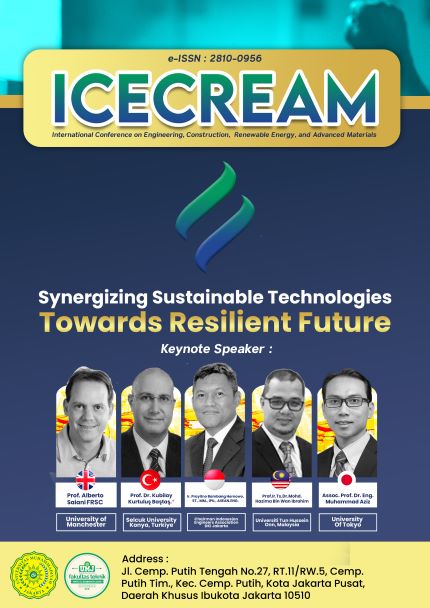Analysis of the Impact of Fire on Oil Storage Tanks at PT X: ALOHA Model Approach for Vapor Cloud Explosion Modeling
Abstract
This research aims to re-evaluate the potential hazards threatening the safety of workers and communities in the environment of the fuel oil terminal, focusing on the pertalite product tank 53 as a case study. ALOHA modeling is employed, with variables including wind speed and atmospheric stability. The methodology involves ALOHA modeling with consideration of fuel oil type, wind speed, and direction. The farthest threat zone is identified within the yellow zone, extending up to 975 meters for toxic areas and 148 meters for flammable areas, potentially impacting the Surabaya Integrated Terminal area. The potential hazards are classified as High Risk, capable of causing multiple fatalities if the worst-case scenario materializes in storage tank no. 53 with Pertalite products. Wind speed influences dispersion distance; higher wind speeds result in decreased contaminant concentration. Similarly, atmospheric stability plays a role in dispersion distance; less stability leads to better dispersion of contaminants.Keywords: Fuel Oil Terminal, ALOHA, Vapor Cloud Explosion ModelingReferences
19403-File Utama Naskah-101564-1-10-20231120. (n.d.).
Dwi, E., Kantor, S. B., & Sidoarjo, C. (n.d.). IJOSH CC BY NC-SA.
Suryani, A. I., Isranuri, I., Mahyuni, E. L., S2, A., Kerja, K., Usu, F., Departemen, S. P., Mesin, T., & Usu, F. T. (n.d.). Pengaruh Potensi Bahaya terhadap Risiko Kecelakaan Kerja di Unit Produksi Industri Migas PT. X Aceh The Effect of Hazard Potential on Workplace Accident Risk at Production Unit of Oil and Gas Industry PT X Aceh.
Inanloo, B., & Tansel, B. (2015). Explosion impacts during transport of hazardous cargo: GIS-based characterization of overpressure impacts and delineation of flammable zones for ammonia. Journal of Environmental Management, 156, 1–9. https://doi.org/10.1016/j.jenvman.2015.02.044
Guarnaccia, J., & Hoppe, T. (2008). Off-site toxic consequence assessment: A simplified modeling procedure and case study. Journal of Hazardous Materials, 159(1), 177–184. https://doi.org/10.1016/j.jhazmat.2007.09.123
Pramono, A., Sutaryani, A., Tamara Qothrunada, D., Satria, H. W., Kelautan dan Perikanan Republik Indonesia, K., & Meteorologi Klimatologi dan Geofisika, B. (2022). Seminar Nasional TREnD Technology of Renewable Energy and Development FTI Universitas.
Irawan, S., Panjaitan, T. W., & Yenny Bendatu, L. (2015). / Penyusunan Hazard Identification Risk Assessment and Risk Control (HIRARC) di PT. In Jurnal Titra (Vol. 3, Issue 1).
Hasad, A. (n.d.). VERIFIKASI DAN VALIDASI DALAM SIMULASI MODEL.
Witlox, H. W. M., Fernandez, M., Harper, M., Oke, A., Stene, J., & Xu, Y. (2018). Verification and validation of Phast consequence models for accidental releases of toxic or flammable chemicals to the atmosphere. Journal of Loss Prevention in the Process Industries, 55, 457–470. https://doi.org/10.1016/j.jlp.2018.07.014
Bakatsoula, V. D., Korras-Carraca, M. B., Hatzianastassiou, N., & Matsoukas, C. (2023). A comparison of atmospheric aerosol absorption properties from the MERRA-2 reanalysis with AERONET. Atmospheric Environment, 311. https://doi.org/10.1016/j.atmosenv.2023.119997
Office of Response, N. (2013). ALOHA® (Areal Locations Of Hazardous Atmospheres) 5.4.4: Technical Documentation.
Nauli, T. (n.d.). POLA SEBARAN POLUTAN DARI CEROBONG ASAP.
Annas Setyo, G., Eko Handriyono, R., Teknik Lingkungan, J., & Teknik Sipil dan Perencanaan Institut Teknologi Adhi Tama Surabaya, F. (n.d.). Analisis Penyebaran Gas Karbon Monoksida (Co) Dari Sumber Transportasi Di Jalan Tunjungan Surabaya.
Astri, A., Lingkungan, J. T., Lansekap, A., & Lingkungan, T. (2009). PRODUKSI GAS HASIL BIODEGRADASI MINYAK BUMI: KAJIAN AWAL APLIKASINYA DALAM MICROBIAL ENHANCED OIL RECOVERY (MEOR). In Makara Journal of Science (Vol. 13, Issue 2). https://scholarhub.ui.ac.id/scienceAvailableat:https://scholarhub.ui.ac.id/science/vol13/iss2/48
Gant, S., Weil, J., Delle Monache, L., McKenna, B., Garcia, M. M., Tickle, G., Tucker, H., Stewart, J., Kelsey, A., McGillivray, A., Batt, R., Witlox, H., & Wardman, M. (2018). Dense gas dispersion model development and testing for the Jack Rabbit II phase 1 chlorine release experiments. Atmospheric Environment, 192, 218–240. https://doi.org/10.1016/j.atmosenv.2018.08.009
Leppert, J., Horner, G., Rietz, F., Ringer, J., Schulze Lammers, P., & Boeker, P. (2012). Near real time detection of hazardous airborne substances. Talanta, 101, 440–446. https://doi.org/10.1016/j.talanta.2012.09.056
Mazzola, T., Hanna, S., Chang, J., Bradley, S., Meris, R., Simpson, S., Miner, S., Gant, S., Weil, J., Harper, M., Nikmo, J., Kukkonen, J., Lacome, J. M., Nibart, M., Björnham, O., Khajehnajafi, S., Habib, K., Armand, P., Bauer, T., … Ek, N. (2021). Results of comparisons of the predictions of 17 dense gas dispersion models with observations from the Jack Rabbit II chlorine field experiment. Atmospheric Environment, 244. https://doi.org/10.1016/j.atmosenv.2020.117887
Mohammadfam, I., & Zarei, E. (2015). Safety risk modeling and major accidents analysis of hydrogen and natural gas releases: A comprehensive risk analysis framework. International Journal of Hydrogen Energy, 40(39), 13653–13663. https://doi.org/10.1016/j.ijhydene.2015.07.117
Piringer, M., Knauder, W., Petz, E., & Schauberger, G. (2016). Factors influencing separation distances against odour annoyance calculated by Gaussian and Lagrangian dispersion models. Atmospheric Environment, 140, 69–83. https://doi.org/10.1016/j.atmosenv.2016.05.056
Pouyakian, M., Ashouri, M., Eidani, S., Madvari, R. F., & Laal, F. (2023). A systematic review of consequence modeling studies of the process accidents in Iran from 2006 to 2022. Heliyon, 9(2). https://doi.org/10.1016/j.heliyon.2023.e13550
Ramadhan, R., Marzuki, M., Suryanto, W., Sholihun, S., Yusnaini, H., & Muharsyah, R. (2024). Rainfall variability in Indonesia new capital associated with the madden-julian oscillation and its contribution to flood events. Quaternary Science Advances, 100163. https://doi.org/10.1016/j.qsa.2024.100163
Ridha, A. E., & Hanggara, S.T., M.T, F. D. (2023). Model Area Explosion pada Storage Benzene di Industri Refenery Minyak Bumi (Studi Kasus : PT. PERTAMINA Refinery IV Cilacap). Jurnal Media Teknik Dan Sistem Industri, 7(1), 10. https://doi.org/10.35194/jmtsi.v7i1.2011
Ruhiat, Y., & Pascasarjana, S. (2009). MODEL PREDIKSI DISTRIBUSI LAJU PENYEBARAN SULFUR DIOKSIDA (SO 2 ) DAN DEBU DARI KAWASAN INDUSTRI (STUDI KASUS DI KOTA CILEGON).
Tauseef, S. M., Rashtchian, D., & Abbasi, S. A. (2011). CFD-based simulation of dense gas dispersion in presence of obstacles. Journal of Loss Prevention in the Process Industries, 24(4), 371–376. https://doi.org/10.1016/j.jlp.2011.01.014
Witlox, H. W. M., Harper, M., Natarajan, S., & Williamson, A. (2015). Modelling of time-varying dispersion for elevated pressurised releases without rainout. Journal of Loss Prevention in the Process Industries, 35, 283–292. https://doi.org/10.1016/j.jlp.2014.12.001
Yang, S., & Kar, S. (2024). First report on chemometric modeling of tilapia fish aquatic toxicity to organic chemicals: Toxicity data gap filling. Science of the Total Environment, 907. https://doi.org/10.1016/j.scitotenv.2023.167991

